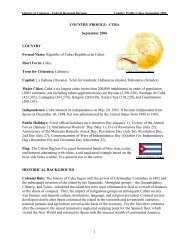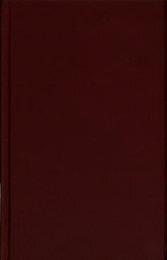Anton Webern's Six Pieces for Ocrhestra, op. 6, Arrangement for ...
Anton Webern's Six Pieces for Ocrhestra, op. 6, Arrangement for ...
Anton Webern's Six Pieces for Ocrhestra, op. 6, Arrangement for ...
Create successful ePaper yourself
Turn your PDF publications into a flip-book with our unique Google optimized e-Paper software.
in Quellenstudien I: Gustav Mahler-Igor Strawinsky-<strong>Anton</strong> Webern-Frank Martin<br />
(Veröffentlichungen der Paul Sacher Stiftung, 2), ed. Hans Oesch (Winterthur: Amadeus,<br />
1991), pp. 53-100; Felix Meyer/Anne Shreffler, "<strong>Webern's</strong> Revisions: Some Analytical<br />
Implications," in Music Analysis 12/3 (1993): 355-79.<br />
29 The revised version has been available in a pocket score since 1956 (Philharmonia<br />
Scores No. 394). Even be<strong>for</strong>e this version had been produced (in the summer of 1928),<br />
Webern apparently undertook a new reorchestration <strong>for</strong> a planned per<strong>for</strong>mance under<br />
Hermann Scherchen; cf. Erich Wolfgang Partsch, "Ergänzungen zur<br />
Verbreitungsgeschichte von Weberns Sechs Orchesterstücken <strong>op</strong>. 6," in 40,000<br />
Musikerbriefe auf Kn<strong>op</strong>fdruck: Methoden der Verschlagwortung anhand des UE-<br />
Briefwechsels-Untersuchungen-Detailergebnisse, ed. Ernst Hilmar (Tutzing: H. Schneider,<br />
1989), pp. 55-62.<br />
30 Cf. <strong>Webern's</strong> notation to this effect in a program book from the year 1933, quoted by<br />
Moldenhauer, <strong>Anton</strong> von Webern (see note 6), p. 128.<br />
31 Due to the shortening mentioned, the revised version's measure numbers differ from<br />
those of the original version by one.<br />
32 Letter to Arnold Schoenberg of August 20, 1928, quoted after Moldenhauer, <strong>Anton</strong> von<br />
Webern (see note 6), p. 128.<br />
33 Mention should also be made here of <strong>Webern's</strong> later reservation with regard to the<br />
programmatic dimension of his music, as can be seen from the way he described his music.<br />
For example, while in a letter of January 13, 1913, to Arnold Schoenberg, Webern refers<br />
extensively to the autobiographical background of the <strong>Six</strong> <strong>Pieces</strong>- -the funeral of his<br />
mother in 1906--in the program note of 1933 mentioned above (see note 30), he limits<br />
himself to the following cues: "expectation of catastr<strong>op</strong>he" (No. 1), "certainty of its<br />
fulfillment" (No. 2), "the most tender contrast" (No. 3), "funeral march" (No. 4),<br />
"remembrance" (No. 5), "resignation" (No. 6); quoted after Moldenhauer, <strong>Anton</strong> von<br />
Webern (see note 6), p. 128.<br />
34 Cf. Joachim Noller, "Fasslichkeit-eine kulturhidtorische Studie zur Ästhetik Weberns,"<br />
in Archiv für Musikwissenschaft 43/3 (1986): 169-80. It was by no means accidental that<br />
Webern remarked that the revised orchestral version, as distinct from the original version,<br />
looked "like an old Haydn score." (Letter of August 20, 1928, to Alban Berg: quoted from<br />
Moldenhauer, <strong>Anton</strong> von Webern [see note 6], p. 129).



![Albert Einstein Papers [finding aid]. Library of Congress. [PDF ...](https://img.yumpu.com/21604228/1/190x245/albert-einstein-papers-finding-aid-library-of-congress-pdf-.jpg?quality=85)





![American Colony in Jerusalem Collection [finding aid]. Library of ...](https://img.yumpu.com/17941275/1/190x245/american-colony-in-jerusalem-collection-finding-aid-library-of-.jpg?quality=85)



![Piccard Family Papers [finding aid]. - American Memory - Library of ...](https://img.yumpu.com/17941234/1/190x245/piccard-family-papers-finding-aid-american-memory-library-of-.jpg?quality=85)


